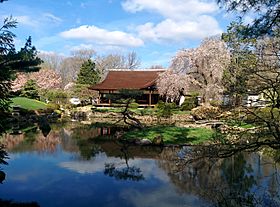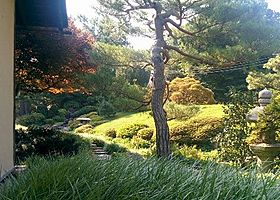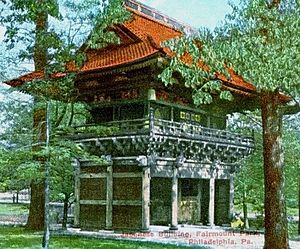Shofuso Japanese House and Garden facts for kids
Quick facts for kids Japanese House |
|
|---|---|

Bright blue sky over the Japanese House.
|
|
| Alternative names | Shofuso |
| General information | |
| Architectural style | Shoin-Zukuri (17th Century) |
| Address | Horticultural and Lansdowne Drs. West Fairmount Park |
| Town or city | Philadelphia |
| Country | United States |
| Coordinates | 39°58′53″N 75°12′47″W / 39.9814°N 75.213°W |
| Opened | 1954 |
| Relocated | 1958 |
| Renovated | 1976 |
| Design and construction | |
| Architect | Junzo Yoshimura |
| Other designers | Heizaemon Ito, 11th (Master carpenter) |
Shofuso (Pine Breeze Villa), also known as the Japanese House and Garden, is a special traditional Japanese house. It was built in the style of a 17th-century Japanese home. You can find it in West Fairmount Park in Philadelphia. This beautiful place also has a peaceful Japanese garden.
Shofuso is a non-profit historic site. It welcomes over 30,000 visitors every year. You can visit it and even take group tours.
This house was a gift from Japan to the people of America in 1953. It was meant to show peace and friendship after World War II. The house was built using real Japanese methods and materials. It was first shown in New York City at the Museum of Modern Art (MoMA). After two years, it was moved to Philadelphia and rebuilt in 1958.
In 1976, Japanese artists helped restore the house. This was done for America's 200th birthday celebration. Later, in 2007, a famous Japanese artist named Hiroshi Senju created 20 amazing waterfall murals for the inside of the house.
The city of Philadelphia owns Shofuso. A private non-profit group called the Japan America Society of Greater Philadelphia takes care of it. They make sure it stays beautiful and open for everyone to enjoy.
Contents
How Shofuso Came to Be
The Museum of Modern Art (MoMA) in New York used to have "House in the Garden" exhibits. In 1949, they started showing different types of houses in their courtyard. The museum's leaders thought that modern Western houses were similar to traditional Japanese homes. So, they decided to build a Japanese house for their third exhibit.
In 1953, John D. Rockefeller III and MoMA's curator, Arthur Drexler, visited Japan. They asked Japanese business leaders for help with the project. The Japan-America Society (JAS) agreed to support it. They decided the Japanese House should be a gift from Japan to the American people. This gift would help share Japanese culture.
Many companies and people in Japan donated money for the project. The Japanese government even allowed special wood, called "hinoki" cypress, to be used. This wood was hard to get.
A special committee chose a 17th-century style house called shoin-zukuri. This style is a great example of traditional Japanese architecture. They picked Junzo Yoshimura to design the house. He was a talented architect. The 11th-generation master carpenter, Heizaemon Ito, was chosen to build it. His family had been master builders for the ruling family of Japan for centuries.
Shofuso at MoMA
Building the house started in Japan in 1953. It was put together using old Japanese methods. These methods use very few nails. Instead, carpenters use special joints made with hand tools. The house was finished in about a year.
Then, the house was taken apart and shipped to New York. Architect Yoshimura and his team arrived in New York in March 1954. They rebuilt the house by mid-June. The opening ceremony was held on June 17, 1954. Shofuso opened to the public two days later.
The Japanese Prime Minister, Shigeru Yoshida, visited Shofuso in November 1954. Americans loved the house's natural wood and simple design. The exhibit closed in October 1955. Almost a quarter of a million people visited it! This was three times more visitors than MoMA's previous house exhibits.
The Nio-Mon Temple Gate
Before Shofuso arrived, there was another Japanese building in Fairmount Park. It was called the Nio-Mon Temple Gate. This gate was built around 1600 in Japan. It was first shown at the 1904 World's Fair in St. Louis. After the fair, it was bought and moved to Fairmount Park.
The area around the gate was made into a Japanese garden in 1909. It had a lotus pond. Sadly, a fire completely destroyed the Temple Gate on May 6, 1955. This event, by chance, created the perfect spot for Shofuso to be rebuilt.
Moving to Philadelphia
Many people asked MoMA if Shofuso could stay open forever. MoMA decided to give Shofuso as a gift to Philadelphia's Fairmount Park Commission. This was a good idea because there was already a Japanese garden in the park.
In 1958, the carpenter Okumura and gardener Sano came back from Japan. They had helped build Shofuso at MoMA. They rebuilt Shofuso in its new home in Philadelphia. The house and garden opened to the public on October 19, 1958.
Over time, Shofuso started to show wear and tear. In 1975, Philadelphia's Mayor Frank Rizzo asked Japan for help. He wanted to restore Shofuso for America's 200th birthday in 1976. The Japan-America Society raised money for a full restoration of the house and garden. This happened in June 1976.
To keep Shofuso in good shape, a non-profit group was started in 1982. It was called the Friends of the Japanese House & Garden. This group managed Shofuso until 2016. Then, it joined with the Japan America Society of Greater Philadelphia. This larger group also puts on the Subaru Cherry Blossom Festival of Greater Philadelphia.
Amazing Waterfall Murals
When Shofuso was at MoMA, its special alcove and sliding doors had black ink murals. These were painted by Kaii Higashiyama. Sadly, they were damaged.
In 2003, a famous Japanese painter named Hiroshi Senju offered to donate 20 new murals to Shofuso. Senju's murals show beautiful waterfalls. He even created a special "Shofuso color" for them. This color was made by mixing colors from the house and garden. The paintings were done on special mulberry paper.
Shofuso is the only place in the United States that combines modern Japanese art with traditional Japanese architecture. The city of Philadelphia officially showed Senju's murals on April 27, 2007. Mayor John F. Street even declared April 27 "Senju Day."
House Design
Shofuso was designed to look like a guest house from a temple in Japan. This temple was called Kojo-in and was built in 1601. The guest house at Kojo-in had four main parts of shoin-zukuri architecture. These included a built-in desk, staggered shelves, a special alcove called a toko-no-ma, and an ornamental doorway.
The house was built using a set of rules for how each part should be sized. This helped the builders make everything look harmonious. Architect Yoshimura changed the Kojo-in design a bit for MoMA. He added a kitchen, bathroom, and tea house to make it a working home. He wanted Americans to understand traditional Japanese architecture. The tea house part was copied from a famous tea house in Kyoto.
The Garden
| Shofuso's garden | |
|---|---|

Bright haze looking at the waterfall from the Tea Garden
|
|
| Location | Horticultural and Lansdowne Drs. West Fairmount Park, Philadelphia, United States |
| Area | 1.2 acres |
| Created | 1958 |
| Designer | Tansai Sano |
| Operated by | Friends of the Japanese House and Garden |
| Visitors | 18,000 |
| Open | April through October |
| Designation | National Register of Historic Places |
The garden at Shofuso was designed by Tansai Sano. He was a landscape architect from Kyoto, Japan. His family had taken care of the famous dry garden at Ryoan-ji temple for six generations. Eighty large stones were brought from an old temple in central Japan for the garden at MoMA.
The first Japanese garden in Fairmount Park was built in 1909. It was for the Nio-Mon Temple Gate. When Shofuso moved to Philadelphia in 1957, Tansai Sano changed the garden design. He added a waterfall and new plants. In 1976, during a big restoration, Ken Nakajima made more changes.
The Journal of Japanese Gardening has ranked Shofuso's garden very highly. It was named the third-best Japanese garden in North America in 2004, 2008, and 2013. There are over 300 Japanese gardens in North America!
See also
 In Spanish: Casa y jardín japonés Shofuso para niños
In Spanish: Casa y jardín japonés Shofuso para niños
- List of houses in Fairmount Park
- List of Japanese gardens in the United States
- Philadelphia Register of Historic Places




